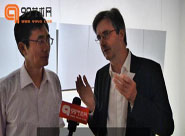Ground Scenery in the Memory
Since the art institution moves from Guanghua Road near east of the 3rd ring of Beijing to Tsinghua Yuan in Haidian district in 2005, Yuanmingyuan Park became one of my favorite places to visit: not because the glory and shame over one hundred years ago, since what the event has destroyed is the scenery of the royal family, inside the site you can still find emerald green and the glow of sunset. What I am really interested in Yuanmingyuan are those trails buried in weeds and the vestiges of villages which came into being spontaneously and were destroyed by force. More than ten years ago, those feisty people in our generation have been looking for the ideal of Utopia there, and formed an art community outside the power circle. From today’s perspective, their short stays in Yuanmingyuan unexpectedly become one romantic and also painful page of the whole Chinese contemporary art history. It is said that today the Haidian government is very regret to miss the most “beneficial” culture industry. At that time, those misery young artists were banished from Yuanmingyuan, and they looked for their shelter towards east, toward the sunglow, and finally they found the Song Village in Tongzhou at the banks of Chaobai River. Ten years ago I went to the Village to visit friends; it was still just like the most common countryside in Beijing suburb and the artists had a very hard time, but they never complained about this: on one hand they drew, on the other hand they took care of their rural life. You could see hope in their eyes. While today the Village seems already being the cradle of a contemporary myth, there officers, farmers, businessmen, artists satisfy of one and all, and a spectacular artistic ecological-chain has formed. At the entrance of the village where hangs the bronzing words “China Song Village”, I encountered several students who just graduated from the institution and came here. During the conversation with them, I found here has already become the “base” where young artists desired. Yang Wei and Hong Feng have told me about “the miracle in Song Village” and both of them believed that the miracle came into being too sudden and too fast to accept for those elder artists who have experienced the Yuanmingyuan era.
From the art community in Yuanmingyuan to the Song Village nowadays, the umbilical cord of art is always there and never been cut off. That is a way of life, an existence of free spirit. Now although I walk in Yuanmingyuan, my heart is in the Village together with my friends who set up their business there; I am thinking about the banks of Chaobai River far away from the royal Fengshui.
Song Village has attracted many talented people from various fields with its unique charm. Here I am talking about Li Tiejun, the director of Beijing Museum of Contemporary Art (MOCA), an energetic artist. In 1990s, he went to Bolivia, where Che Guevara has strived in and then he went to Spain to study. He chooses Song Village to be his base after he came back to China. Beijing MOCA sits in verdant woods in the Village; grey walls, mast of different heights, gravel road make the place much more a private club than a museum if there is no exhibition opening ceremony. Tiejun lead me to Tianguang Studio in the backyard. The winding path, the sound of cicada after the rain, the fog and the sculptures scatter in woods, all these sceneries has almost wiped away my memory of the Village ten years ago.
In such a peaceful environment, people originally should enjoy life, but Tiejun creates series of work which had great impact, such as The Ground Scenery, Fog, Nature, and Colored Dogs. All his paintings are in large size, with black, white or grey color. The vague frame makes the scenery not like scenery. Does he mix up the boundary of memory in his years of adventure? And in his finished works, the indulged use and flow of colours and inks tear up those vague images. Is he deliberately using violence to destroy the peace of the scenery? I do not intensively want to know what the artist want to review in his paintings, what I am more concerned is his way of speaking. Tiejun has a yearning daily practice of gentle landscape paintings and calligraphy, and I believe his benefit from that will affect his expression of ground sceneries.
Like me keeping the memory of Song Village, in Tiejun’s memory, there is also unique ground scenery. Memory is the most important value experience in our life. It mixes the time and space, even put aside of them, making the image sometimes vague and sometimes clear. Most people use photographing to keep their memory, while Tiejun put it directly on his paintings. From the view of molding language, the non-determinacy of image could prevent massive narration effectively, thus makes all artist’s saying just a hint. There is no recurrence, no lecture.
Generally speaking, people could see scenery because people are there, thus the ground is not a general and abstract natural space, but a specific environment where living individuals could express themselves. Tiejun change “space” into specific “ground”. We can say the “ground” where modern people live is not only full of beneficial conflicts and cultural conflicts between people and people, but also full of contradictions between people and thing, or people and being. “Scenery Amnesia” in psychology is usually an expression of such conflict and contradiction. Bus, railway and plane, all those modern technological items in Tiejun’s works are very common to people, but behind them are the living pressure of people, the reasonable rule which people would like to bear unconsciously. Maybe, Tiejun’s painting could only use a vague and “violent” way to express the weak existence of individual life in contemporary technology system.

